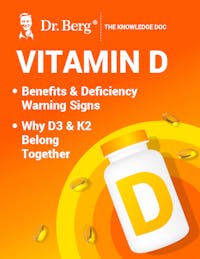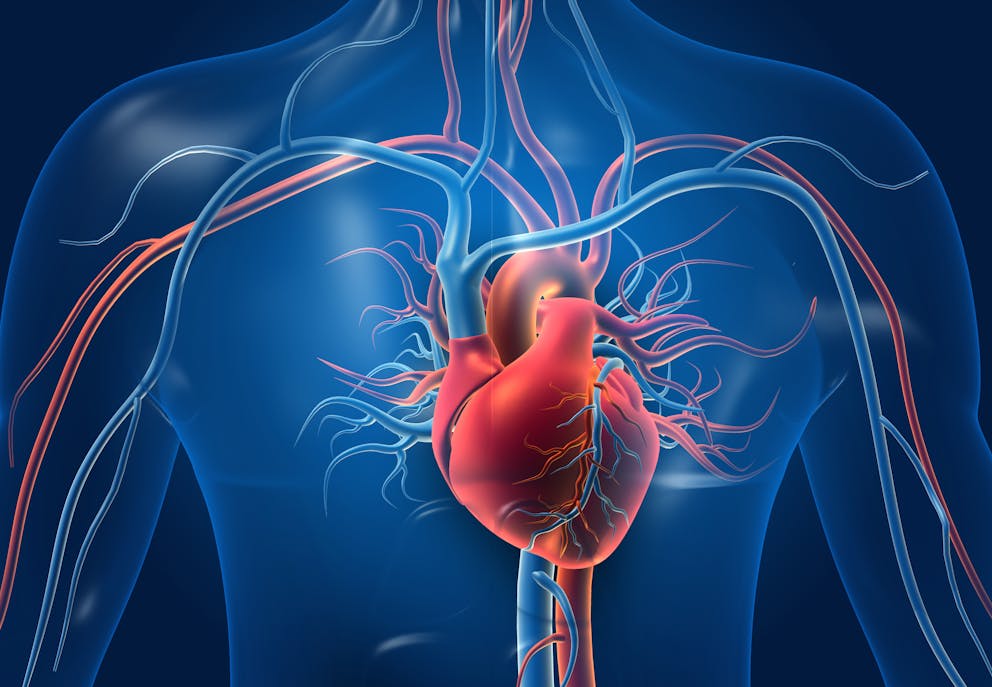Vitamin D3: Health Benefits, Sources, Dosage, & Risks

Vitamin D – Benefits and Deficiency Warning Signs
Learn to recognize early signs of vitamin D deficiency
Discover how to maintain healthy vitamin D levels
Explore common factors that can contribute to vitamin D deficiency
Understand why vitamin D3 and K2 should always be taken together
Get practical advice on how to maximize the health benefits of vitamin D

Vitamin D – Benefits and Deficiency Warning Signs
Learn to recognize early signs of vitamin D deficiency
Discover how to maintain healthy vitamin D levels
Explore common factors that can contribute to vitamin D deficiency
Understand why vitamin D3 and K2 should always be taken together
Get practical advice on how to maximize the health benefits of vitamin D

Vitamin D – Benefits and Deficiency Warning Signs
Learn to recognize early signs of vitamin D deficiency
Discover how to maintain healthy vitamin D levels
Explore common factors that can contribute to vitamin D deficiency
Understand why vitamin D3 and K2 should always be taken together
Get practical advice on how to maximize the health benefits of vitamin D

Vitamin D – Benefits and Deficiency Warning Signs
Learn to recognize early signs of vitamin D deficiency
Discover how to maintain healthy vitamin D levels
Explore common factors that can contribute to vitamin D deficiency
Understand why vitamin D3 and K2 should always be taken together
Get practical advice on how to maximize the health benefits of vitamin D

Vitamin D – Benefits and Deficiency Warning Signs
Learn to recognize early signs of vitamin D deficiency
Discover how to maintain healthy vitamin D levels
Explore common factors that can contribute to vitamin D deficiency
Understand why vitamin D3 and K2 should always be taken together
Get practical advice on how to maximize the health benefits of vitamin D

Vitamin D – Benefits and Deficiency Warning Signs
Learn to recognize early signs of vitamin D deficiency
Discover how to maintain healthy vitamin D levels
Explore common factors that can contribute to vitamin D deficiency
Understand why vitamin D3 and K2 should always be taken together
Get practical advice on how to maximize the health benefits of vitamin D

Vitamin D – Benefits and Deficiency Warning Signs
Learn to recognize early signs of vitamin D deficiency
Discover how to maintain healthy vitamin D levels
Explore common factors that can contribute to vitamin D deficiency
Understand why vitamin D3 and K2 should always be taken together
Get practical advice on how to maximize the health benefits of vitamin D

Vitamin D – Benefits and Deficiency Warning Signs
Learn to recognize early signs of vitamin D deficiency
Discover how to maintain healthy vitamin D levels
Explore common factors that can contribute to vitamin D deficiency
Understand why vitamin D3 and K2 should always be taken together
Get practical advice on how to maximize the health benefits of vitamin D

Vitamin D – Benefits and Deficiency Warning Signs
Learn to recognize early signs of vitamin D deficiency
Discover how to maintain healthy vitamin D levels
Explore common factors that can contribute to vitamin D deficiency
Understand why vitamin D3 and K2 should always be taken together
Get practical advice on how to maximize the health benefits of vitamin D

Vitamin D – Benefits and Deficiency Warning Signs
Learn to recognize early signs of vitamin D deficiency
Discover how to maintain healthy vitamin D levels
Explore common factors that can contribute to vitamin D deficiency
Understand why vitamin D3 and K2 should always be taken together
Get practical advice on how to maximize the health benefits of vitamin D

Vitamin D – Benefits and Deficiency Warning Signs
Learn to recognize early signs of vitamin D deficiency
Discover how to maintain healthy vitamin D levels
Explore common factors that can contribute to vitamin D deficiency
Understand why vitamin D3 and K2 should always be taken together
Get practical advice on how to maximize the health benefits of vitamin D

Vitamin D – Benefits and Deficiency Warning Signs
Learn to recognize early signs of vitamin D deficiency
Discover how to maintain healthy vitamin D levels
Explore common factors that can contribute to vitamin D deficiency
Understand why vitamin D3 and K2 should always be taken together
Get practical advice on how to maximize the health benefits of vitamin D

Vitamin D – Benefits and Deficiency Warning Signs
Learn to recognize early signs of vitamin D deficiency
Discover how to maintain healthy vitamin D levels
Explore common factors that can contribute to vitamin D deficiency
Understand why vitamin D3 and K2 should always be taken together
Get practical advice on how to maximize the health benefits of vitamin D

Vitamin D – Benefits and Deficiency Warning Signs
Learn to recognize early signs of vitamin D deficiency
Discover how to maintain healthy vitamin D levels
Explore common factors that can contribute to vitamin D deficiency
Understand why vitamin D3 and K2 should always be taken together
Get practical advice on how to maximize the health benefits of vitamin D

Vitamin D – Benefits and Deficiency Warning Signs
Learn to recognize early signs of vitamin D deficiency
Discover how to maintain healthy vitamin D levels
Explore common factors that can contribute to vitamin D deficiency
Understand why vitamin D3 and K2 should always be taken together
Get practical advice on how to maximize the health benefits of vitamin D

Vitamin D – Benefits and Deficiency Warning Signs
Learn to recognize early signs of vitamin D deficiency
Discover how to maintain healthy vitamin D levels
Explore common factors that can contribute to vitamin D deficiency
Understand why vitamin D3 and K2 should always be taken together
Get practical advice on how to maximize the health benefits of vitamin D

Vitamin D – Benefits and Deficiency Warning Signs
Learn to recognize early signs of vitamin D deficiency
Discover how to maintain healthy vitamin D levels
Explore common factors that can contribute to vitamin D deficiency
Understand why vitamin D3 and K2 should always be taken together
Get practical advice on how to maximize the health benefits of vitamin D

Vitamin D – Benefits and Deficiency Warning Signs
Learn to recognize early signs of vitamin D deficiency
Discover how to maintain healthy vitamin D levels
Explore common factors that can contribute to vitamin D deficiency
Understand why vitamin D3 and K2 should always be taken together
Get practical advice on how to maximize the health benefits of vitamin D

Vitamin D – Benefits and Deficiency Warning Signs
Learn to recognize early signs of vitamin D deficiency
Discover how to maintain healthy vitamin D levels
Explore common factors that can contribute to vitamin D deficiency
Understand why vitamin D3 and K2 should always be taken together
Get practical advice on how to maximize the health benefits of vitamin D

Vitamin D – Benefits and Deficiency Warning Signs
Learn to recognize early signs of vitamin D deficiency
Discover how to maintain healthy vitamin D levels
Explore common factors that can contribute to vitamin D deficiency
Understand why vitamin D3 and K2 should always be taken together
Get practical advice on how to maximize the health benefits of vitamin D

Vitamin D – Benefits and Deficiency Warning Signs
Learn to recognize early signs of vitamin D deficiency
Discover how to maintain healthy vitamin D levels
Explore common factors that can contribute to vitamin D deficiency
Understand why vitamin D3 and K2 should always be taken together
Get practical advice on how to maximize the health benefits of vitamin D

Vitamin D – Benefits and Deficiency Warning Signs
Learn to recognize early signs of vitamin D deficiency
Discover how to maintain healthy vitamin D levels
Explore common factors that can contribute to vitamin D deficiency
Understand why vitamin D3 and K2 should always be taken together
Get practical advice on how to maximize the health benefits of vitamin D

Vitamin D – Benefits and Deficiency Warning Signs
Learn to recognize early signs of vitamin D deficiency
Discover how to maintain healthy vitamin D levels
Explore common factors that can contribute to vitamin D deficiency
Understand why vitamin D3 and K2 should always be taken together
Get practical advice on how to maximize the health benefits of vitamin D

Vitamin D – Benefits and Deficiency Warning Signs
Learn to recognize early signs of vitamin D deficiency
Discover how to maintain healthy vitamin D levels
Explore common factors that can contribute to vitamin D deficiency
Understand why vitamin D3 and K2 should always be taken together
Get practical advice on how to maximize the health benefits of vitamin D

Vitamin D – Benefits and Deficiency Warning Signs
Learn to recognize early signs of vitamin D deficiency
Discover how to maintain healthy vitamin D levels
Explore common factors that can contribute to vitamin D deficiency
Understand why vitamin D3 and K2 should always be taken together
Get practical advice on how to maximize the health benefits of vitamin D

Vitamin D – Benefits and Deficiency Warning Signs
Learn to recognize early signs of vitamin D deficiency
Discover how to maintain healthy vitamin D levels
Explore common factors that can contribute to vitamin D deficiency
Understand why vitamin D3 and K2 should always be taken together
Get practical advice on how to maximize the health benefits of vitamin D

Vitamin D – Benefits and Deficiency Warning Signs
Learn to recognize early signs of vitamin D deficiency
Discover how to maintain healthy vitamin D levels
Explore common factors that can contribute to vitamin D deficiency
Understand why vitamin D3 and K2 should always be taken together
Get practical advice on how to maximize the health benefits of vitamin D

Vitamin D – Benefits and Deficiency Warning Signs
Learn to recognize early signs of vitamin D deficiency
Discover how to maintain healthy vitamin D levels
Explore common factors that can contribute to vitamin D deficiency
Understand why vitamin D3 and K2 should always be taken together
Get practical advice on how to maximize the health benefits of vitamin D
Vitamin D deficiency affects almost half of all U.S. adults, and vitamin D supplementation is a convenient and safe way to promote healthy vitamin D status.
Vitamin D3, also known as cholecalciferol, is a potent form of vitamin D that’s easily absorbed, highly effective at raising vitamin D levels, and linked to minimal side effects.
Let’s look at the incredible health benefits of vitamin D3 and learn why supplemental vitamin D should always be combined with vitamin K2.

What is vitamin D3?
Vitamin D is produced when the skin is exposed to sunlight, which explains why it’s commonly referred to as the sunshine vitamin.
Sunlight contains ultraviolet B (UVB) radiation that can penetrate the skin and trigger biochemical reactions that convert previtamin D into active vitamin D3.
How much vitamin D is produced in response to sun exposure depends on many factors.
Older individuals and those with darker skin pigmentation may not generate enough vitamin D even if exposed to adequate sunlight, leaving the elderly and people with darker skin tones at risk of vitamin D deficiency.
“Vitamin D3 is a fat-soluble vitamin that's primarily stored in fat cells and the liver,” explains Dr. Berg. “While the body tends to store enough vitamin D to compensate for short periods without UVB radiation, limited sun exposure for prolonged time will lead to vitamin D insufficiency.”
Watch the video below to learn how much vitamin D you need to maintain a healthy body.
How is vitamin D3 different from vitamin D2?
Vitamin D naturally occurs as vitamin D2, also known as ergocalciferol, and vitamin D3, or cholecalciferol.
While vitamin D3 is produced in response to sunlight and can be found in a few food sources, including fatty fish, fish liver oils, egg yolks, and beef liver, vitamin D2 is primarily found in UVB-exposed mushrooms and yeasts.
Compared to vitamin D3, vitamin D2 is easy to manufacture and is a common ingredient in low-quality, over-the-counter vitamin D supplements.
Although vitamins D2 and D3 are structurally similar, vitamin D3 is easily absorbed, significantly more effective, and can be stored in the body for longer periods, making it the preferred form of vitamin D supplement.
A study published in The Journal of Clinical Endocrinology and Metabolism states, “D3 is approximately 87% more potent in raising and maintaining serum vitamin D concentrations and produces a two to threefold greater storage of vitamin D than D2.”

Four health benefits of vitamin D3
Vitamin D is vital for health and regulates calcium balance, nerve signal transmission, immune defenses, and neurotransmitter production.
Vitamin D plays such a fundamental role in various physiological functions that many scientists argue it should be classified as a hormone to emphasize its importance and the need to maintain optimal levels.
Here are four health benefits of vitamin D3.
1. Improves bone health
Vitamin D helps the body absorb calcium, an essential mineral necessary to develop strong bones and maintain skeletal health.
Without vitamin D, only a small percentage of dietary and supplemental calcium can be absorbed, significantly increasing the risk of calcium deficiency.
Due to its role in maintaining healthy bones, vitamin D3 helps lower the risk of bone fractures and osteoporosis.
2. Supports a strong immune system
Vitamin D3 stimulates the activity of white blood cells, including T-cells, Natural Killer cells (NK), and macrophages, the body's primary defense against microbial infections and diseases.
Vitamin D also balances the ratio of immune cells, which strengthens immunity and lowers the risk of autoimmune diseases such as multiple sclerosis, Crohn’s disease, and type 1 diabetes.
Research published by Harvard Medical School found that vitamin D appears to lower prostate, colon, and breast cancer risk.
It’s believed that vitamin D’s role in enhancing immune cell function increases the body’s ability to detect and eliminate abnormal and potentially carcinogenic cells.

3. Promotes cardiovascular health
Evidence suggests that individuals with higher vitamin D status have a reduced risk of cardiovascular disease.
Vitamin D may help improve endothelial function, which is crucial for maintaining healthy blood vessels and lowering the risk of high blood pressure.
Lack of adequate vitamin D is linked to endothelial dysfunction, a condition characterized by vascular damage and a narrowing of vessels—prime risk factors for atherosclerosis and heart disease.
4. Supports mental health
Poor mental health can develop due to a complex interplay of underlying imbalances and nutrient deficiencies, and vitamins aimed at stress and anxiety can alleviate symptoms and enhance overall health.
Vitamin D has been found to influence various areas of the brain and promotes the production of serotonin, a neurotransmitter that regulates moods.
Vitamin D deficiency has been associated with an increased risk of depression and anxiety, which may explain why mood disorders often develop during winter when adequate sunshine exposure is limited.

How much vitamin D3 do you need?
Vitamin D3 plays an essential role in a wide range of physiological functions, and low vitamin D levels can have serious health consequences.
Muscle weakness, bone pain, frequent infections, depression, acne, hair loss, and sore gums could be a sign of vitamin D deficiency.
It’s well established that vitamin D3 supplements can correct a deficiency and help maintain optimal vitamin D stores.
The National Institutes of Health (NIH) suggests a daily vitamin D dose of 600 IU. However, 600 IU of vitamin D isn’t enough to significantly increase blood vitamin D levels.
In fact, research published in StatPearls found that it may require between 5,000 and 10,000 IU of vitamin D3 daily to prevent deficiency in most people.
Your appropriate dose of vitamin D3 depends on your vitamin D levels, age, health status, medication use, and average sunlight exposure.
If you are considering taking vitamin D, it’s recommended to consult a healthcare provider to perform a simple vitamin D test, which helps guide an effective and safe supplement dose.

The importance of taking vitamin D3 with vitamin K2
Combining vitamin D3 and K2 benefits bone tissue mineralization and plays a crucial role in keeping your cardiovascular system healthy.
Vitamin D3 enhances the body’s ability to absorb calcium. This can lead to elevated blood calcium levels, which is linked to an increased risk of arterial calcification, a primary risk factor for heart attacks and stroke.
Vitamin K2 redirects excessive calcium from the blood and stimulates its deposition into bone tissue. This not only promotes strong bones and skeletal health but also significantly lowers the risk of cardiovascular disease.
For optimal absorption, the ideal ratio of vitamin D3 to K2 is 1000:10, which means it’s recommended to take 10 mcg of vitamin K2 per 1000 IU of vitamin D3.
Other benefits of vitamin K2
Taking vitamin D3 and K2 together doesn’t just promote skeletal and cardiovascular health.
Because fat-soluble vitamins are needed for skin cell renewal and wound healing, regular consumption of vitamins D3 and K2 can enhance skin health.
Vitamin K2 may also play an important role in reproductive and sexual health.
Due to its blood-clotting properties, vitamin K2 can help lighten heavy menstrual cycles, and some studies link vitamin K2 with improved erectile dysfunction.
During pregnancy, vitamin K is crucial for both the mother and the developing fetus, and taking vitamin K2 while pregnant has been found to promote healthy fetal bone tissue development and reduce the risk of excessive bleeding during childbirth.

Sources of vitamin D3
The most natural way to maintain healthy vitamin D3 levels is by exposing your skin to sunlight for 10 to 30 minutes several times a week.
However, geographical locations with latitudes higher than 42° north of the equator lack adequate UVB radiation, especially during the winter months, leaving large proportions of the population at risk of insufficient vitamin D status.
While there are a few dietary sources of vitamin D3, such as oily fish, cod liver oil, organ meats, and egg yolks, these foods typically contain only small amounts, which won’t be enough to promote healthy vitamin D stores.
Vitamin D3 can also be taken in supplemental form, and a study published in The American Journal of Clinical Nutrition indicates that dietary supplements are the most effective and reliable strategy to maintain optimal vitamin D levels.

Vitamin D3 supplementation
Vitamin D supplements are widely available. However, not all vitamin D-containing products are the same, and knowing how to choose a high-quality supplement helps maximize the health benefits of vitamin D3.
Vitamin D3 is significantly more effective than vitamin D2, and choosing a product that contains cholecalciferol is crucial.
In addition, opt for a vitamin D3 and K2 balanced product with a ratio of at least 100 mcg of vitamin K2 per 10,000 IU of vitamin D.
While some people absorb as much as 80 percent of supplemental vitamin D, people with digestive disorders, poor gallbladder function, or malabsorption issues may absorb less than 50 percent.
If you suffer from gastrointestinal issues or sluggish digestion, prioritize vitamin D3 products that include medium-chain triglycerides (MCTs) and ox bile.
Combining vitamin D3 with MCTs and bile salts enhances the solubility of fat-soluble vitamins, including vitamins D3 and K2, and increases their absorption into the bloodstream.

Vitamin D3 risks
If taken in appropriate doses, vitamin D3 is considered safe and less likely to cause side effects than vitamin D2.
However, it’s important to be aware that vitamin D is a fat-soluble vitamin that can accumulate in the body, and taking too much vitamin D3 may lead to adverse health consequences.
Vitamin D toxicity
Vitamin D toxicity, also known as hypervitaminosis D, is a rare but potentially serious condition characterized by elevated vitamin D levels.
Hypervitaminosis D is typically caused by prolonged intake of high-dose supplementation or linked to certain medical conditions, such as kidney disease, which can impair the urinary excretion of vitamin D.
Here are common symptoms associated with vitamin D toxicity:
Nausea and vomiting
Unexplained weight loss
Dehydration
Excessive urination
Confusion
Elevated blood calcium levels
If you are experiencing symptoms of vitamin D toxicity, it’s crucial to consult a healthcare provider for a thorough medical evaluation and blood tests to assess vitamin D levels.

Vitamin D3 interactions
Taking vitamin D with certain diuretic drugs can increase the risk of elevated calcium levels, a potentially serious electrolyte imbalance that can lead to an irregular heartbeat and mental confusion.
There is also evidence that vitamin D can interact with lithium-containing anti-seizure drugs, and it’s best to discuss vitamin D supplementation with your healthcare provider if you are taking prescription medications.
According to StatPearls Research, medications used for weight loss, corticosteroids, cholesterol-lowering drugs, and certain laxatives can alter vitamin D metabolism or decrease the intestinal absorption of vitamin D.
Potential side effects
Gastrointestinal issues such as nausea and stomach pains are among the most common side effects of vitamin D and are typically linked to low-quality supplements that contain vitamin D2.
Liquid vitamin D3 drops or vitamin D3 supplements containing MCT oil and ox bile are generally easier to digest and lower the risk of intestinal issues.
Individuals with certain medical conditions, such as hyperparathyroidism, lymphoma, or bone cancer, are at increased risk of elevated calcium levels and should avoid taking additional vitamin D to reduce calcium-related health issues such as arterial calcification.

Key takeaways
Vitamin D is crucial for physical health and mental well-being, and a deficiency can lead to skeletal issues, autoimmune disease, and mood disorders.
It can be challenging to obtain adequate vitamin D levels from sunlight exposure and dietary sources alone, and taking a vitamin D3 supplement is a safe and convenient strategy to prevent deficiency and maintain healthy vitamin D stores.
Vitamin D3 is easily absorbed, highly effective in raising vitamin D blood levels, and linked to a lower risk of side effects than vitamin D2.
FAQ
1. What is vitamin D3?
Vitamin D3 is a fat-soluble vitamin that’s produced when the skin is exposed to ultraviolet B (UVB) radiation in sunlight.
UVB rays trigger a complex cascade of biochemical reactions that convert pre-vitamin D into active vitamin D3.
2. What does vitamin D3 do for the body?
Vitamin D3 plays a vital role in regulating various physiological functions, including bone mineralization, calcium balance, cognitive processes, and immune cell activation.
3. What are the benefits of vitamin D3?
Vitamin D3 promotes skeletal health, neurotransmitter balance, strong immune defenses, and brain function.
Maintaining adequate vitamin D3 stores can reduce the risk of autoimmune diseases, osteoporosis, certain cancers, depression, and age-related cognitive decline.
4. How can I get vitamin D3 naturally?
Exposure to sunlight is the most natural way to get vitamin D3.
However, individuals who are overweight, have a darker skin tone, or live at latitudes greater than 42° north of the equator may not produce adequate vitamin D3 from sunlight, leaving them at an increased risk of deficiency.
5. Are vitamin D3 supplements safe?
Yes, vitamin D3 supplements are generally considered safe for most individuals.
Vitamin D3 is highly effective, readily absorbed, and less likely to cause side effects compared to vitamin D2-containing supplements.
6. How much vitamin D3 do I need daily?
How much vitamin D3 you need to maintain healthy levels depends on your vitamin D levels, sunlight exposure, health status, and skin tone.
Most healthcare providers suggest 600 IU of vitamin D daily. However, it may require significantly higher doses of up to 10,000 IU daily to correct a vitamin D deficiency.
7. Should I take vitamin D3 or vitamin D2?
Vitamin D3 is the preferred form of vitamin D supplement.
It’s more potent and readily absorbed into the bloodstream and is significantly more effective at raising vitamin D levels than supplements containing vitamin D2.
8. What are the symptoms of vitamin D3 deficiency?
Symptoms of vitamin D3 deficiency include bone pain, low immune defenses, hair loss, muscle weakness, memory problems, acne, and depression.
9. What causes vitamin D3 deficiency?
Lack of adequate UVB radiation is the most common cause of vitamin D3 deficiency. In addition, those with a darker skin tone and the elderly tend to produce less vitamin D, leaving them at risk of deficiency despite adequate sunlight exposure.
There also is evidence that certain medications, such as laxatives, corticosteroids, and weight-loss drugs, can impair intestinal vitamin D absorption linked to deficiency.
10. Can you get vitamin D3 from food?
Some dietary sources of vitamin D3 include oily fish, egg yolks, and organ meats. However, these foods contain only small amounts of vitamin D, which isn’t enough to maintain healthy vitamin D levels.
11. What are the symptoms of vitamin D3 toxicity?
Common symptoms of vitamin D3 toxicity include vomiting, nausea, muscle pain, confusion, unexplained weight loss, and elevated blood calcium levels.
12. Does vitamin D3 interact with medications?
Vitamin D3 supplements can increase the risk of side effects of lithium-containing anti-seizure drugs and diuretics.
In addition, certain weight-loss drugs, statins, laxatives, and steroid medications can impair vitamin D absorption and increase the risk of insufficient vitamin D levels.
13. Can bile salts enhance vitamin D3 absorption?
Bile salts are needed to solubilize dietary fats and fat-soluble nutrients, including vitamin D3, which makes it easier for the body to absorb dietary and supplemental vitamin D3 into the bloodstream.
14. Why do I need to take vitamin K2 with vitamin D3?
Because vitamin D stimulates calcium absorption, it can lead to elevated levels of blood calcium, a potentially dangerous imbalance that can increase the risk of soft tissue calcification and heart disease.
Vitamin K redirects circulating calcium into bone tissue, which promotes healthy calcium balance and can help prevent arterial calcification, a main risk factor for heart attacks and stroke.
15. Can MCT oil increase vitamin D3 bioavailability?
Taking medium-chain triglyceride (MCT) oil with vitamin D3 enhances the body’s ability to absorb vitamin D3 into the bloodstream.
Vitamin D is fat-soluble and relies on the presence of fatty acids in the digestive tract to enter the liver. MCT oil offers a quickly absorbed source of fat that helps solubilize and absorb dietary and supplemental vitamin D3.
Previous blog
Vitamin D3 and K2 Benefits – How They Work TogetherTags

Popular
08/21/2024
43.6K views
05/22/2024
39.1K views
11/18/2024
228.1K views
03/18/2024
11/21/2022




